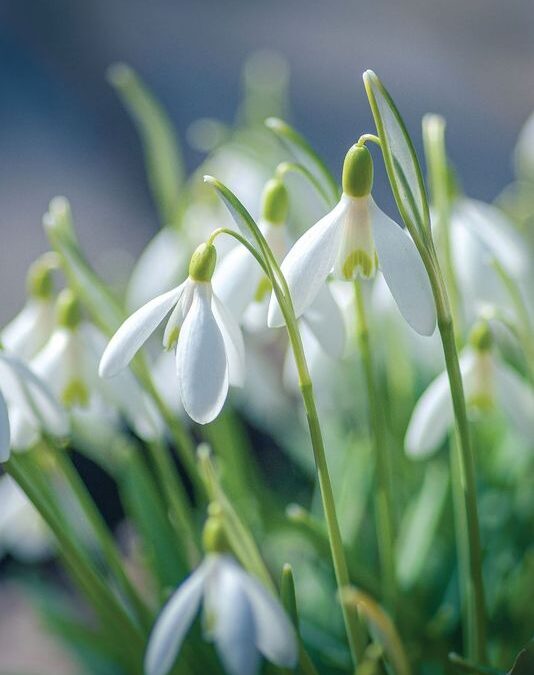In praise of snowdrops
There’s something magical about snowdrops with their dainty white heads appearing in dreary mid-winter, giving us a reason to be cheerful.
The most common variety, Galanthus nivalis – roughly translated as ‘milk white flower ’ has a single flower and green v- shaped markings on the inner petals, and G. nivalis ‘Flore Pleno’ is a frillier double version. But there are hundreds of cultivars with subtle differences in size, markings and colouring.
Snowdrops are woodland plants and thrive in moist, well-drained soil, in dappled shade. They look wonderful naturalised in grass or carpeting the ground under deciduous trees. But they also work in drifts in borders or underplanting shrubs or multi-stems such as silver birch. Pick a spot, such as a front garden or somewhere visible from a window, were you can appreciate them easily. Or pop them in some pots near the house so that you can admire them as you pass.
Companion plants
Aim for naturalism by planting snowdrops in little clumps of three, five or seven, with about 20 or so in total for impact. Snowdrops look stunning interplanted with tiny pinky purple Cyclamen coum or other delicate early spring bulbs such as Crocus tommasinianus creating a pretty tapestry.
Hellebores are great snowdrop partners, particularly the inky purple varieties of Helleborus x hybridus. Ferns are also natural partners, loving the same damp shady conditions. For a monochrome statement try dotting snowdrops amongst low growing black grass, Ophiopogon planiscapus ‘Nigrescens’. The colourful red and orange stems of cornus (Dogwood) also provide a great backdrop. Another option is a pot large enough for them to get enough moisture and nutrients, as you’ll be able to appreciate their delicate beauty up close.
Growing tips…
Snowdrops are best bought in the green, before the leaves have died down, around March. Plant them straight away to avoid them drying out, to the original depth (the leaves that were below soil will be paler). Add sharp sand or grit to heavy soil to improve drainage and firm them in. Leave on the foliage until it dies naturally, as this feeds the bulbs for next year. If you have large colonies, divide them in March by carefully lifting a clump with a spade and planting as above.
Box: Snowdrop gardens and walks in and around London
Ham House and Garden: Just along the river from Richmond, this is a great day out. Admire the snowdrops in the woodland garden, followed by a warming cuppa in the café. Some of the beautiful 17th Century house is also open in the winter. Nationaltrust.org.uk
Kew Gardens: A hearty walk around the 300 acres should keep you warm – head to the Rock Garden and Davies Alpine House for your snowdrop fix. Kew.org
Ightham Mote: The estate and gardens at Ightham Mote are open in February for a stroll around the grounds, spotting snowdrops as you go. Nationatrust.org.uk
Hever Castle: Around 80,000 snowdrops have been planted to create a trail. Look out for unsual varieties such as yellow tipped ‘Wendy’s Gold’, or a giant 9 inch variety called ‘Colossus.’ Hevercastle.co.uk
Polesden Lacey: Tucked away in the Surrey Hills, this is a great London escape for wintry walks around the estate and snowdrop spotting in the Winter Garden. Nationaltrust.org
The National Garden Scheme’s snowdrop festival has hundreds of gardens teeming with snowdrops.

